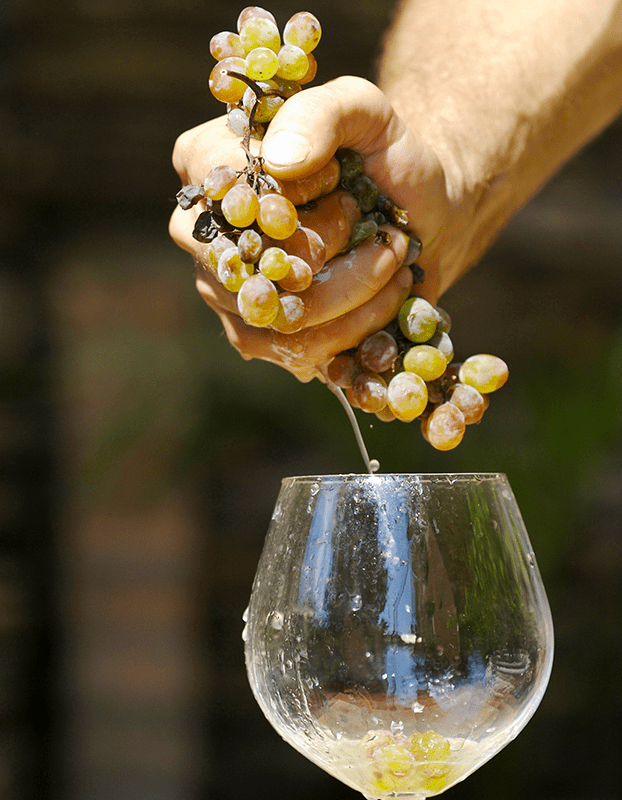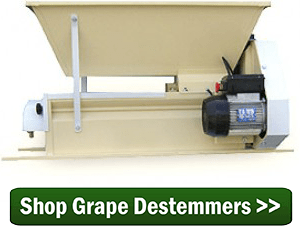 You say grapes must be crushed before pressing, what do you use to crush them with?
You say grapes must be crushed before pressing, what do you use to crush them with?
Thank you,
Tony
—–
Hello Tony,
Crushing the wine grapes is a very straight forward process. All you want to do is burst the skin of each grape. This is necessary to release the juice from the grape. It also allows the yeast and enzymes into the grape to further break down the fiber and release even more juice along with flavor and body elements that will make up the character of the resulting wine.
If you do not crush the grapes, you will discover that a significant number of grapes will not release any juice at all. They will stay whole when being pressed. Other grapes may only give up a marginal amount of their juice while being squeezed. This is true regardless of the type of wine press you are using.
On the flip-side, you do not want to over-crush the wine grapes. Doing so may release too much tannin. This could lead to a wine that is out of pH balance and bitter tasting. You just want to solidly burst the skins. As an example, don’t pull out the food processor. That is not how to crush grapes and would definitely be overkill!
Another aspect to consider is that you need to remove the stems from the wine grapes at some point. A few stems are okay, but you do not want all of the stems in the fermentation. This too will cause the wine to become overly bitter with excessive tannin.
How you tackle the crushing of the grapes will depend on the amount of grapes you are dealing with. If you have just 10 or 20 pounds it wouldn’t be a bad idea to crush them by hand. With 100 pounds you might get away with crushing the grapes by beating them with the butt end of a 2×4 while in a bucket. But anything beyond this, and you are going to want to start considering an actual grape crusher.
We offer four different grape crushers. They all crush the wine grapes equally well. The biggest difference between these crushers is speed. Some have de-stemmers with them, or you can de-stem the grapes by hand. Regardless, if you have a large pile of grapes, using one of these units is how you will want to crush your grapes:
- Wooden Fruit Crusher: This is the smallest grape crusher we offer. It is hand-cranked and easily does about 80 to 100 pounds an hour. It is well designed and will crush small berries as will as larger fruit.

- Stainless Steel Fruit Crusher: This is a manual grape crusher as well. The main differences are that it is rated at 1850 pound per hour and it is stainless steel, very easy to clean up. It also has rotating knives within the hopper for handling other types of fruit.
- Motorized Crusher / De-stemmer: This is a motorize grape crusher. And as the name suggests, it is also a grape de-stemmer. The crushed grapes fall out the bottom and the stems will come out the side of the unit. It is rated at 2,200 pounds per hour.
I hope this information helps you out and gives you a better idea of how to crush your grapes. The bottom line is the wine grapes need to be crushed before they can be made into wine, and they need to be crushed by the right amount. Burst the skins thoroughly, but don’t do more than that.
Happy Wine Making,
Ed Kraus
—————
Ed Kraus is a 3rd generation home brewer/winemaker and has been an owner of E. C. Kraus since 1999. He has been helping individuals make better wine and beer for over 25 years.

Richard, thanks for bringing up such a good point. What goes for the grapes discussed above also goes for most other fruit. Using the squizzo processor is overkill on the blackberries and blueberries. It can even be detrimental to the quality of the resulting wine. Just break them up by hand or use a potato masher or something similar.
I have I found that even more than cutting them in half is excessive. The Grapes will end up with just empty shells when you’re done fermenting, no need to get excited.
Hi, I am 5years new at wine making and as i was preparing to add my wine yeast i noticed that the must was already fermenting so i let it go without adding the yeast, is this safe? should i still add the wine yeast? Any other info would be great.
Thanks Ray
Ray, what is happening is that wild yeast is doing the fermenting. Since letting the wild yeast ferment could result in off flavors in the wine, I would recommend adding one campden tablet per gallon of wine to destroy the wild yeast. Once you have done this, cover the fermenter with a towel, wait 24 hours and add a packet of wine yeast. Below you will find the link to an article that will discuss this in more detail.
How Does Wine Ferment Without Adding Yeast
http://www.eckraus.com/blog/how-does-a-wine-ferment-without-adding-yeast
All true , it only cost a couple dollars to kill the yeast in start over with some good new yeast but I haven’t really had any bad wine resulting from letting the grapes ferment by themselves. If you are competing with winking owl every couple of dollars helps.
How do you think it was done in the old days. I’ve made several that way.
I am getting ready to make a blackberry/blueberry wine. I guess I never thought it over regarding the crushing for these berries. Should I use the same precaution regarding the tanins in either fruit. Can I overcrush these? I was going to juice them through a squizzo processor and then take the skins/cellulose and put them in a bag during fermentation. What would you reccommend? Making six gallons using 8 to 10 lbs per fruit.
for most fruits (raspberry, blackberry, blueberry, etc.) freeze the fruit. After you thaw it, it will be mush. It can then be strained through a colander, or pressed via a fruit bag, or just fermented after adjusting with water.
Not sure if it would work for grapes but for a 5 gal batch of muscadine wine I use my Kitchenaid mixer with the meat grinder attachment (blades and press plates removed). When the fruit is pulled through it they are popped perfectly and ready to press.
Once they’re popped they don’t need anything else.
How long can I keep the grapes in the cases before I crush them? Waiting for my cousin to come up.
Thanks.
Chris, if you do nothing to the grape but let them sit you do not have that much time at all — 2 days, maybe. But what you can do to help preserve them is to spray them down with a water/sulfite solution. This will destroy any immediate mold or bacteria that may be getting at the grapes. Realize, this will also destroy the wild yeast on the grapes, so domesticated wine yeast will need to be added. Use a solution of 1 teaspoon of potassium metabisulfite or sodium metabisulfite with each gallon of water. Spray liberally onto the grapes. This should get you 3 or 4 days of safe keeping.
My grape wine is bitter after racking. After reading it seems that I over crushed the grapes. Can this be corrected now or is this batch ruined?
James, from what you say it sounds like the wine is still fermenting. If this is the case, it is normal for the wine to taste bitter at this stage. The bitterness can be caused by yeast still floating around. I would wait until the fermentation completes and the wine has aged a little before making any adjustments. After that, if the wine is still bitter, you might have excess tannin from over-processing the grapes. If the problem is excessive tannin, you can try treating the wine with Bentonite to help drag out some of the tannin. Below I have posted a couple of articles that will discuss this in more detail.
My Homemade Wine Is Bitter
http://www.eckraus.com/blog/removing-the-bitterness-from-a-homemade-fruit-wine
http://www.eckraus.com/blog/our-wine-tastes-a-little-bitter-what-should-i-do
You didn’t mention the traditional method of “pigeage avec les pieds.”
Any introduced bacteria are killed by grape acidity and sulfite. Bare feet do not crush excessively, and do not crush pips. It creates a slippery mess, and some support is advisable, to prevent falling. It’s painful if the grapes are very cold. Muscadines especially have a lot of acid, and will irritate skin for a day or so afterward. I suggest doing 20 – 30 pounds of grapes at a time in a polyethylene tub, then pour into a larger container.
I have my daughter crush the grapes with her feet. She started when she was 4 and is still doing it at 9 !
Hilarious, I wish I’d thought of that when my daughters were young. I might borrow a grandson or two!
One method you did NOT mention is the steam juicer. I recently used your model to juice
some Scuppernong grapes and the results were excellent.
I have been using an apple crusher to crush my muscadines for 10 years .It is fast and efficient .They are squeezed enough to break the skin without being smushed .
I am new to wine making. I crushed my Muscatine an then added the pectic enzyme and the bisulfite immediately after crushing. Will the bisulfite regard the action of the enzyme? Should I add more enzyme after initial aging and addition of the yeast?
Charles, it is perfectly fine that you added the bisulfite and pectic enzyme at the same time. The only thing you do not want to add at that time is the yeast.
can you make wine without crushing the grapes?
When crushing the grape the goal is to burst each berry. To do anything more than this is overkill. You need the juice within the grape to be released and exposed to the fermentation. So not a lot of effort needs to be put into crushing. But yes, they do need to be crushed.